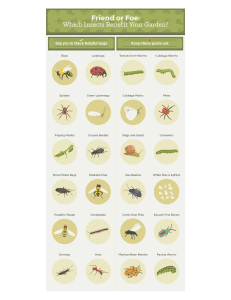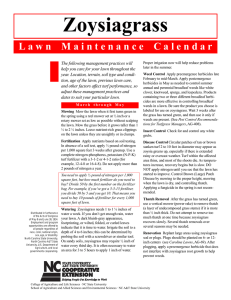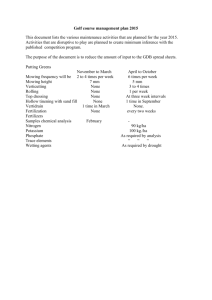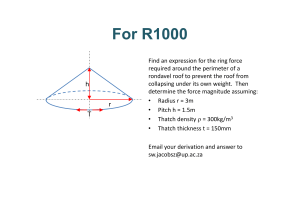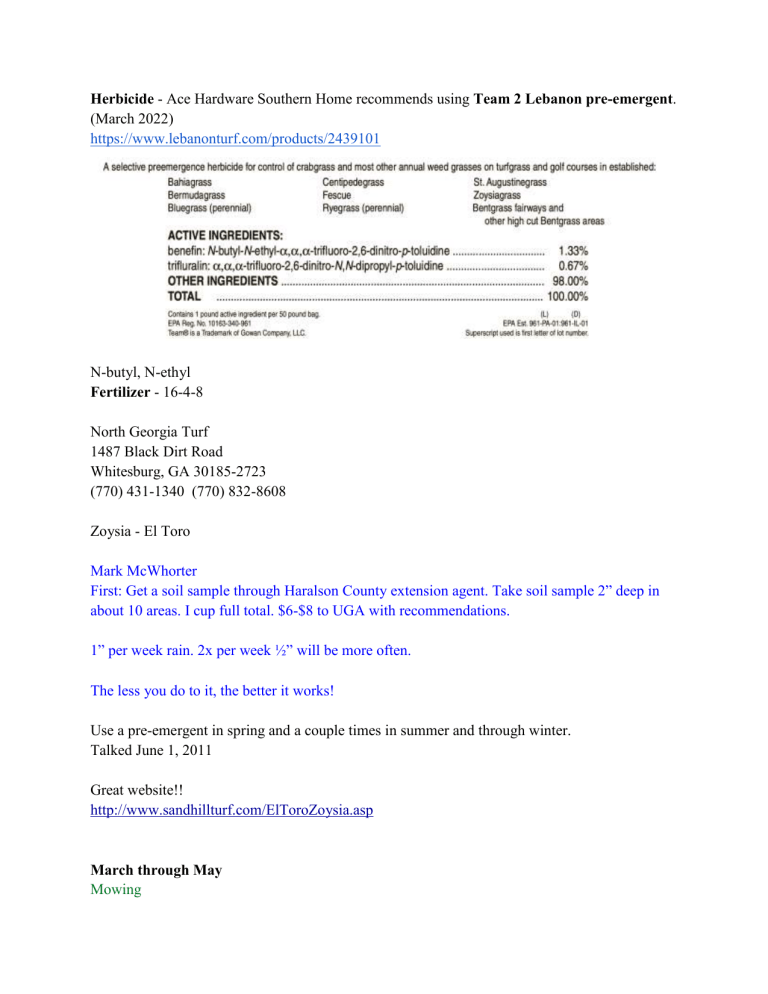
Herbicide - Ace Hardware Southern Home recommends using Team 2 Lebanon pre-emergent. (March 2022) https://www.lebanonturf.com/products/2439101 N-butyl, N-ethyl Fertilizer - 16-4-8 North Georgia Turf 1487 Black Dirt Road Whitesburg, GA 30185-2723 (770) 431-1340 (770) 832-8608 Zoysia - El Toro Mark McWhorter First: Get a soil sample through Haralson County extension agent. Take soil sample 2” deep in about 10 areas. I cup full total. $6-$8 to UGA with recommendations. 1” per week rain. 2x per week ½” will be more often. The less you do to it, the better it works! Use a pre-emergent in spring and a couple times in summer and through winter. Talked June 1, 2011 Great website!! http://www.sandhillturf.com/ElToroZoysia.asp March through May Mowing Mow the lawn when it turns green in the spring using a reel mower set at 3/4 to I inch or a rotary mower set as low as possible without scalping the lawn. Mow before the grass grows taller than 1 1/2 to 2 inches. Recycle nutrients by not collecting clippings unless they are unsightly or in clumps. Fertilization Apply 1/2 pound of nitrogen per thousand square feet 3 weeks after the grass turns green. In absence of a soil test, use a complete (N-P-K) turf-grade fertilizer with a 3-1-2 or 4-1-2 ratio (for example 12-4-8 or 16-4-8). Submit a soil sample to determine nutrient requirements, if you haven’t already done so. (Contact your county Cooperative Extension agent for details.) Apply lime if suggested. Insect Control Check for white grubs and control them if necessary. (See Cooperative Extension Service publication AG-366 White Grub Control in Turf) Thatch Removal Vertically mow (power rake) after the grass turns green to remove thatch if it is more than 1/2 inch thick. Do not attempt to remove too much thatch at one time because zoysiagrass has a slow recovery rate. It may take several years to get thatch under control. Renovation Replant large bare areas using sod or plugs planted on 6- or 12-inch centers. (See Cooperative Extension Service publication AG -69, Carolina Lawns) Apply a pre-emergent herbicide that does not interfere with root growth after plugging to help prevent weed encroachment. Crabgrass, goose grass, dallisgrass, nutsedge, annual sedges, and sandbur can be controlled with post emergent grass control herbicides. Two or three applications 7 to 10 days apart are required for effective control. Zoysiagrasses are sensitive to these compounds, so select the application carefully. June through August Mowing Follow the March-May mowing guidelines. Fertilizer Apply 1/2 pound of nitrogen per thousand square feet in late June or early July and using March - May fertilizer guidelines. Irrigation Follow the March-May irrigation guidelines. Weed Control Apply post emergent herbicides as needed to control summer annual and perennial broadleaf weeds, such as knotweed, purge, and lespedeza. Do not apply post-emergent herbicides unless weeds are present, grass is actively growing, and the lawn is not suffering from drought stress. (See Cooperative Extension Service publication AG-408. Pest Control Recommendations felt Turfgrass Managers.) Insect Control Follow the March-May insect control guidelines. August is the best time to control grubs because they are very small and close to the soil surface. Thatch Removal Vertically mow (power mow) in June using the March-May thatch removal guidelines. September through November Mowing Mow the lawn using the March-May guidelines. Fertilization Fertilize with 1 pound of potash (K20)2 using 1.6 pounds of muriate of potash (0-0-60), 2 pounds of potassium sulfate (0-0-50), or 5 pounds of sul-po-mag (0-0-22) per thousand square felt. To determine the amount of product required to apply 1 pound of potash per thousand square feet, divide 100 by the third number in the fertilizer ratio. For example, for a 6-6-12 fertilizer, divide 100 by 12. The result is 8.3 pounds of product per thousand square feet. Irrigation Follow the March-May irrigation guidelines. Dormant zoysiagrass may still need to be watered periodically when warm, windy weather prevails. Weed Control Apply pre-emergent or post emergent herbicides as needed to control winter annual and perennial broadleaf weeds, such as chickweed and henbit. Pre-emergent herbicides will not control existing perennial weeds. Apply post emergent herbicides only when weeds are present. (See Cooperative Extension Service publication ACS-408, Pest Control Recommendations for Turfgrass Managers.) Insect Control Follow the March-May insect control guidelines. December through February Mowing Follow the March-May mowing guidelines. Zoysiagrass need not be mowed when dormant. Fertilization Do not fertilize. Irrigation Dormant zoysiagrass may need to be irrigated periodically to prevent desiccation, especially when warm, windy weather prevails. Weed Control Apply broadleaf herbicides as necessary to control chickweed, henbit, and hop clover. Selective herbicides can be applied in November or December to control annual bluegrass (Poa annua) and several annual broadleaf weeds. Apply post emergent herbicides only when weeds are present. Maintenance guidelines - April 22, 2011. ● Fertilization - start in May; ½ of what normally needed. Little nitrogen. Soil test through county extension agency. Fertilize 2x year. ● Weeds - county extension Rhizoctonia species
